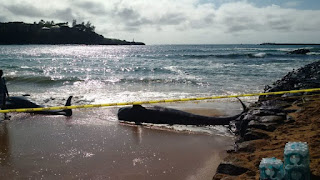Whale and dolphin strandings are generally fatal to the
marine mammals involved, but also traumatize their human cousins who attend
them.
Often, researchers have been unable to figure out why the
animals appear to commit suicide. Now there’s a hint of a clue.
Two of the pilot whales that stranded (image above) on Kaua’i’s Kalapaki
Beach in 2017 suffered from a newly discovered virus that affected multiple
organs.
It was October 13, when five pilot whales drove themselves
onto the sand at the popular beach outside Lihue, and fronting what is now the
Sonesta Kauai resort. People tried pushing the whales back into the sea, but
often they swam or washed right back in. More whales from the same pod were herded away
from the beach by paddlers and surfers, and appeared to have survived and left the bay.
They were short-finned pilot whales, Globicephala macrorhyncus.
A new study of necropsy samples from numerous whale and dolphin strandings—on Kaua’i, O’ahu,
Molokai, Maui, Hawai’i Island, as well as Saipan and American Samoa—shows that those
two Kaua’I animals and many of the other stranded cetaceans were suffering from
a newly discovered beaked whale circovirus.
The study was published today (Jan. 26, 2023) in the journal
Frontiers in Marine Research. Its authors are Cody Clifton and Kristi West of the
University of Hawai’i College of Tropical Agriculture and Human Resources and
the university’s Hawai’i Institute of Marine Biology; Ilse Silva-Krott of Hawai’i
Institute of Marine Biology; and Michael Marsik of the National Marine Fisheries
Service in Pago Pago.
They call the virus an “emergent disease with unknown population impacts.”
The researchers studied archived tissues collected in
necropsies of 30 individuals involved in recent Pacific strandings—including from
the brain, kidney, liver, lung, spleen and lymph nodes. In many cases, the
virus—identified through PCR testing—was found in multiple organs.
The tissues were being stored at the University of Hawai‘i
Health and Stranding Laboratory.
“Of the screened individuals, 15 animals tested positive in
one or more tissues, with a single striped dolphin (Stenella coeruleoalba)
testing positive in all six tissues,” they wrote.
“Brain tissue was the most consistently positive tissue type
(69%), followed by lymph tissue (67%) and lung tissue (64%),” they wrote.
It is not clear whether the viral infection caused or was
directly related to the strandings, but it is a significant medical issue for
marine mammals.
“Infectious diseases pose a major threat to cetaceans and (beaked
whale circovirus) may represent an important emerging disease within
populations spanning the central, Western, and South Pacific,” the authors
wrote.
Different circoviruses are known from pets and wild animals,
including birds, and while they may cause minimal health effects, they can sometimes be
fatal. They can be associated with tissue inflammation as well a tissue death
in organs. They are often associated with difficulty breathing.
And yet, sometimes, animals can be profoundly infected
without showing significant symptoms. A false killer whale accidentally caught
at sea had the virus in its brain, lungs, liver and lymph nodes, and yet appeared
perfectly healthy.
The earliest recognized occurrence of
this virus was in a Longman’s beaked whale (Indopacetus pacificus) that stranded
on Maui in 2010. The presence of this particular virus was not identified until
10 years after its death. That one was a very sick whale. It was infected with
multiple viruses. The authors of the study said multiple infections like this are not
uncommon.
And although that Longman’s Beaked whale gave the virus its
name, the disease has now been found in 10 other species of marine mammal. And
the authors fully expect it to be found in more marine mammals.
A press release on the study is here.
© Jan TenBruggencate 2023










No comments:
Post a Comment